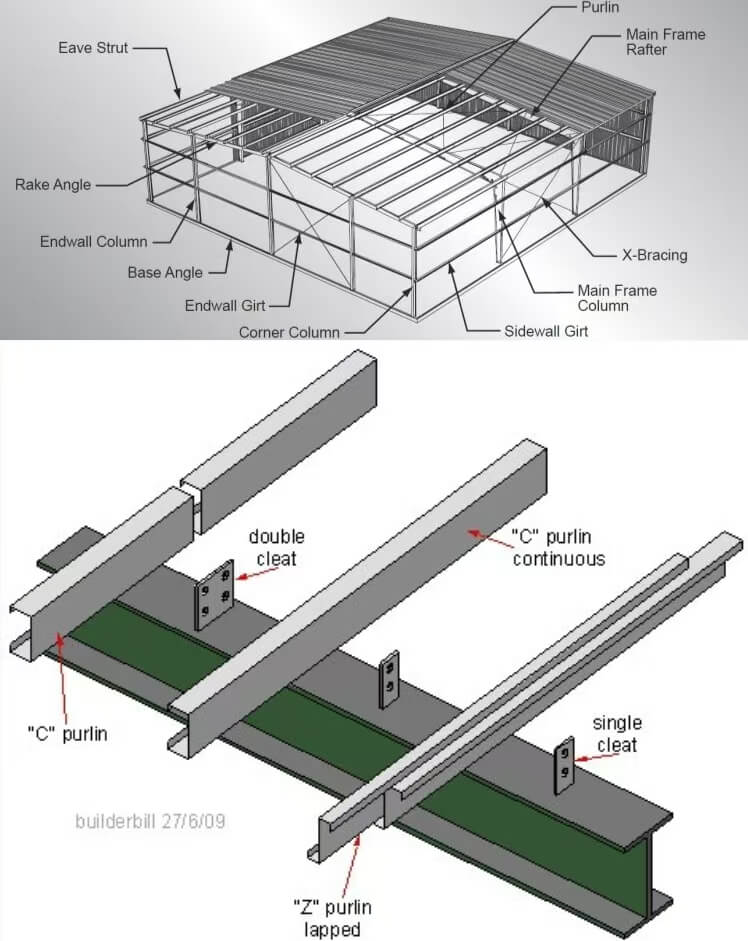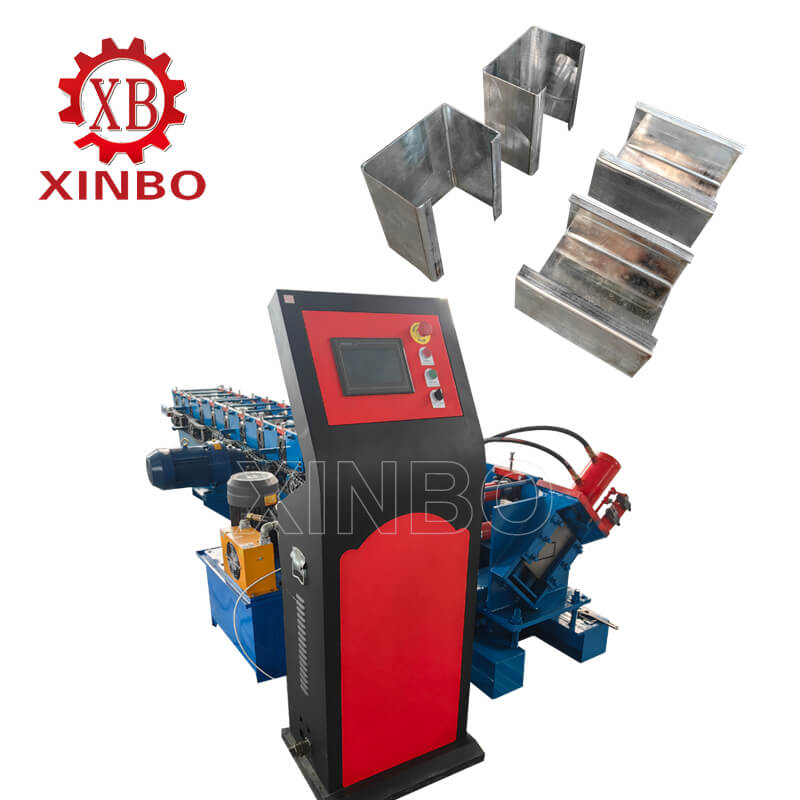Good quality
XinBo machine making CO. LTD is a professional manufacturer and exporter in roll forming machine,
VIEW MORE→Purlins are horizontal beams that provide structural support to roofs and walls in construction projects. They serve as a framework, typically positioned between the main structural components such as rafters or girders. The primary function of purlins is to distribute the load of the roof evenly across the supporting structures, ensuring stability and integrity. By providing an essential support system, purlins also facilitate the attachment of roofing materials, making them a critical element in both residential and commercial building projects.
Purlins are widely utilized in the construction of various types of structures, including warehouses, industrial buildings, and agricultural facilities. They are essential in supporting roof structures made of metal, wood, or concrete. In addition to their structural role, purlins help in enhancing the overall architectural design of buildings. These elements are particularly beneficial in light-frame construction, allowing for faster assembly and reduced labor costs.
Purlin roll forming machines are specialized equipment designed to manufacture purlins from metal strips or sheets. These machines create precise and uniform purlins by continuously feeding metal through a series of rollers that bend and shape it into the desired profile. The efficiency and precision of purlin roll forming machines contribute significantly to modern construction’s speed and cost-effectiveness. These machines allow manufacturers to produce various purlin sizes and shapes, catering to diverse project requirements.

Steel is among the most common materials used for purlins due to its strength and versatility. Its inherent characteristics include high tensile strength and durability, which contribute to a purlin’s ability to bear significant loads. However, using steel does come with some drawbacks, such as susceptibility to rust and corrosion if not properly treated. When considering material options for purlins, it is essential to weigh both the advantages and limitations of steel in the context of the specific construction project.
Steel purlins are known for their high load-bearing capacity, making them ideal for large structures needing robust support. Their construction can be tailored to various shapes and sizes, allowing for flexibility in design. Additionally, steel is available in different grades and finishes, which can enhance its performance in specific environments. The ability to produce steel purlins using purlin roll forming machines makes the manufacturing process efficient and cost-effective.
The primary advantage of using steel for purlins is its excellent structural performance and longevity. However, as mentioned, without proper treatment, steel can corrode, which diminishes its lifespan. Moreover, the weight of steel purlins may require additional support structures to handle the overall building load. It is critical for construction professionals to assess the project’s requirements and environmental conditions when choosing steel as a material option for purlins.
Aluminum has gained popularity as a lightweight alternative for purlins in various applications. Its properties include resistance to corrosion and environmental factors, making it suitable for outdoor use. Additionally, aluminum is significantly lighter than steel, which reduces transportation and installation costs. However, the lower tensile strength of aluminum compared to steel means it may not be suitable for all construction applications, especially those requiring high load-bearing capacities.
The lightweight nature of aluminum allows for easier handling and installation, thereby speeding up the construction process. Furthermore, aluminum does not require protective coatings against corrosion, which can lead to lower maintenance costs over the life of the building. Its excellent aesthetic qualities also mean that aluminum purlins can be used in projects where appearance is a priority, offering various finishes and colors.
While aluminum presents a number of advantages, it is generally more expensive than steel, which might be a limiting factor for some projects. Additionally, when used in large structural applications, aluminum purlins may not perform as effectively under heavy loads. Thus, contractors and builders must analyze the specific application to determine if aluminum is an appropriate choice for purlins.
Galvanized steel purlins offer a solution to the issues of corrosion by applying a protective zinc coating. This coating significantly enhances the material’s resistance to rust and deterioration, making it more suitable for harsh environments. Galvanized steel is commonly used in applications where long-term durability is crucial, providing peace of mind for builders and owners alike.
The galvanized coating not only protects against corrosion but also extends the lifespan of steel purlins, making them a reliable choice for various building projects. The coating provides a self-healing property, allowing minor scratches or chips to become less problematic. Additionally, galvanized steel requires less maintenance over time compared to untreated steel, delivering cost savings for facility managers and owners.
Galvanized steel is particularly suitable for coastal constructions or regions with high humidity, where exposure to moisture is prevalent. Its resistance to environmental degradation makes it the material of choice for agricultural buildings, warehouses, and other commercial structures requiring durable purlins. A careful assessment of site conditions can help determine if galvanized steel is the right option for specific construction purposes.
Stainless steel is renowned for its exceptional durability and strength, providing a robust option for purlins. With its resistance to corrosion and staining, stainless steel purlins are ideal for environments that involve exposure to water, chemicals, or other harsh elements. The resilience of stainless steel ensures that the purlins maintain their structural integrity over time, making them an attractive choice for long-term applications.
Stainless steel purlins are characterized by their sleek finish and low maintenance requirements, which further enhance their appeal in construction projects. The ability to fabricate stainless steel into various profiles through purlin roll forming machines provides greater design flexibility. Moreover, stainless steel’s overall strength allows for thinner profiles that can adequately support larger spans, contributing to efficient design and sustainability.
Selecting stainless steel for purlins is particularly beneficial in applications requiring high corrosion resistance and structural integrity, such as food processing plants and chemical facilities. Its long-term performance justifies the higher upfront costs associated with stainless steel, particularly in projects where durability is a critical concern. Careful consideration of project specifications and environmental factors will guide the decision to use stainless steel versus other material options.
Different materials used for purlins exhibit varying performances based on environmental conditions. When exposed to moisture, galvanized and stainless steel outperform untreated steel due to their enhanced corrosion resistance. Aluminum, while also resistant to corrosion, may not withstand heavy loads as effectively. Understanding the specific environmental challenges a structure will face is essential for selecting the most suitable purlin material.
An effective cost-benefit analysis is vital when evaluating purlin material options. While steel is often the most economical choice upfront, long-term maintenance costs must be considered. Although aluminum and stainless steel typically have higher initial costs, their durability and low maintenance can lead to savings over time. A thorough analysis of construction budgets and long-term operational goals will influence the material selection process.
The longevity and maintenance requirements of purlin materials vastly differ, impacting project decisions. Steel may require periodic coating and maintenance to prevent corrosion, whereas galvanized and stainless steel provide greater resilience with less maintenance. Aluminum’s low maintenance needs resonate well with many contractors, despite its limitations under heavy load. For sustainable building practices, choosing materials that align with lifespan and maintenance objectives is paramount.
Xinbo has established itself as a reputable name in the field of roll forming technology. With a history that spans several years, the brand has made considerable advancements in the design and manufacturing of purlin roll forming machines. The company’s dedication to innovation and quality has earned it recognition and trust among industry professionals. Xinbo’s achievements include successful partnerships with various construction firms, enhancing the efficiency and productivity of their operations.
In its pursuit of excellence, Xinbo offers a comprehensive range of roll forming machines that cater to the needs of the construction industry. The product lineup includes not only purlin roll forming machines but also machinery for producing other essential components such as roof panels, wall panels, and various profiled sheets. Each machine is designed with state-of-the-art technology to ensure high precision, efficiency, and the ability to adapt to different material types, making Xinbo a versatile player in the market.
Innovation is at the heart of Xinbo’s strategy to enhance the capabilities of purlin roll forming machines. The company continuously invests in research and development to incorporate the latest technology into its machines. This includes the implementation of smart manufacturing solutions, which allow for real-time monitoring and data analysis, enabling users to optimize production processes. The advanced technology ensures that purlins produced are of the highest quality while maximizing efficiency and reducing waste.

Xinbo prides itself on its commitment to customer satisfaction, which is evident in its extensive after-sales support. The company provides training to operators, ensuring they are knowledgeable about the functionalities of the purlin roll forming machines. Furthermore, Xinbo offers maintenance services and readily available parts to minimize downtime in production. This level of dedication to customer service not only enhances user experience but also fosters long-term relationships with clients.
When selecting materials for purlins using Xinbo’s roll forming machines, several factors come into play. The first consideration is the structural requirements of the project, which dictates the load-bearing capacities needed from the purlins. Additionally, the environmental conditions where the building will be located significantly influence material choice; for instance, coastal areas may necessitate corrosion-resistant options such as galvanized or stainless steel. Furthermore, budgetary constraints should be evaluated to ensure that the chosen material and associated manufacturing processes align with overall project costs.
Utilizing Xinbo’s roll forming machines can greatly improve the manufacturing process for purlins. For effective use, operators should be well-trained in the machine’s functionalities to take full advantage of its advanced features. Adjustments to settings for different material types, profile specifications, and production speeds are crucial to achieving optimal output. Additionally, regular maintenance checks and adherence to operational guidelines can enhance the lifespan of the equipment, ensuring consistent quality in the production of purlins.
In summary, the selection of materials for purlins in roll forming processes, particularly using Xinbo’s purlin roll forming machines, encompasses a thorough understanding of the applications, advantages, and limitations of each material option. Factors such as environmental conditions, structural requirements, and budget considerations play a pivotal role in this decision-making process. Xinbo’s commitment to innovation, customer support, and effective machinery operation ensures that builders and manufacturers can produce high-quality purlins tailored to meet the diverse needs of construction projects.

XinBo machine making CO. LTD is a professional manufacturer and exporter in roll forming machine,
VIEW MORE→

